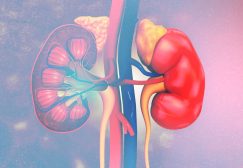Definition
noun, plural: vasopressins
An antidiuretic peptide hormone produced by the magnocellular and the parvocellular neurosecretory cells of the paraventricular nucleus, and by the magnocellular cells in the supraoptic nucleus of the hypothalamus, and then stored and released from the posterior pituitary
Supplement
Vasopressin is a peptide hormone that is secreted from the posterior pituitary. The posterior pituitary is not glandular unlike the anterior pituitary. Nonetheless, it also releases hormones. Apart from vasopressin, oxytocin is also released from it. Oxytocin is similar to vasopressin in several aspects, e.g. structure.
The posterior pituitary does not synthesize vasopressin. Rather, vasopressin is produced in the hypothalamus, and then stored in the posterior pituitary for impending secretion. The neurons (mostly the supraoptic nucleus) in the hypothalamus synthesize a prohormone that is converted into a specific vasopressin as the latter travels down the axon of the neuron that produced it. The axon terminates in the posterior pituitary. It releases vasopressin into the circulation in response to hypertonicity or hyperosmolality of the extracellular fluid. It reacts with the receptors:
- Vasopressin receptor 1A (V1AR) – on the surface of target cells in liver, kidney, peripheral vasculature, and brain
- Vasopressin V1b receptor (V1BR) – on the surface of target cells in pituitary gland and brain
- Vasopressin receptor 2 (V2R) – on the basolateral membrane of the cells lining the collecting ducts of the kidneys, particularly the cortical and outer medullary collecting ducts
The vasopressins are peptide hormones, particularly nonapeptide (i.e. having nine amino acids). There are 4 forms of vasopressins that are identified and occur naturally in vertebrates: (1) arginine vasopressin (or agripressin), (2) lysine vasopressin (or lypressin), (3) phenypressin, and (4) vasotocin. The arginine vasopressin is widespread, occurring in most mammals, including humans. Lysine vasopressin is found in pigs, hippos, warthogs, and some marsupials. Lypressin is used in treating vasopressin deficiency. Phenypressin occurs in some marsupials. Vasotocin is a vasopressin that is found in non-mammalian vertebrates.
Vasopressin, as the name implies, has vasopressor actions. It also has antidiuretic effects. In particular, it regulates blood pressure, stimulating capillary muscles and reduces urine flow by affecting reabsorption of water by kidney tubules. High concentration of vasopressin promotes the reabsorption of water and other compounds in the kidney by making the kidney tubules more permeable to water.
Chemical formula:
- C46H65N15O12S2
Synonym(s):
See also:
- posterior pituitary
- hypothalamus
- pituicyte
- Herring bodies
- hypothalamus
- Argipressin
- Arginine vasopressin receptor 1A
- unit of vasopressin


